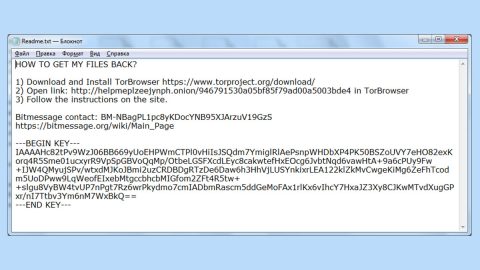Nowadays, as the advancement of technology increases, cyber crimes are undeniably increasing as well. Malware developers intentionally created them for profits, crimes, and other dark motives. These viruses and other types of malware are injected into the websites, either trusted or unknown and alluring victims to click on it and cause damage to the computer’s system and some could even endangered the victim’s life.

What is Jaff Ransomware?
Jaff Decryptor System is a ransomware-type virus unveiled by one of the malware security researchers. This malware appends filenames with the “.jaff” extension and the like. For instance, “sample.jpg” is primarily changed to “sample.jpg.jaff“. Once your files are encrypted, the Jaff Decryptor System creates three files name:(“ReadMe.bmp” [also set as the desktop wallpaper], “ReadMe.txt“, and “ReadMe.html“), placing them in each folder containing encrypted files. If you ever happen to experience this dilemma, be sure to avoid it at all costs. It is absolutely essential to avoid this because this program functions in an extremely malicious manner and is fully capable of encrypting a large number of your personal files where you could not access or read your files, without any notification or authorization.
Harmful Effects of Jaff Ransomware
Basically, it starts its dirty work as soon as it gets through in the system. It initially does full system scan on all the data stored in your hard drive, then later starts the encryption procedure. It’s also found that a malicious program uses a strong cipher known as AES-256 to lock in files on your hard drive. All the files that are affected by such malware is renamed with .jaff extension which indicates that it is locked. The Jaff ransomware targets a large variety of file types such as .doc, .docx, .psd, .ppt, .xml, .mp3, .mp4, .avi, .avi, .png, .jpeg, and many others, and it alters your default wallpaper. To decrypt the files, it will then send a note asking for payment to undo the encryption for 1 Bitcoin. However, there is no assurance that your file are unlocked even after the payment has been made. You can’t know. So what’s best to do is to fully remove the ransomware as soon as possible to maintain and improve your overall virtual security of your PC and files.
How do you get infected by Jaff Ransomware?
Jaff Ransomware is distributed quite actively and in many ways nowadays. Mainly, it is spread via spam e-mail campaigns. So it is critical that you should pay extra attention and avoid email attachments as much as you can. Take note that suspected malicious emails appends on a .pdf attachment and named such as Copy_8533585. Also, remember that just by simply opening a malicious email attachment is enough to infect your computer.
Of course, your best asset to maintain a fully secure operating system at all times is by investing into some professional antimalware tool and have them active on your PC because such a tool can detect and delete any virtual threat in a fully automated manner.
How to remove Jaff Ransomware
These instructions indicate how to fully eliminate the Jaff Ransomware automatically. The instructions need to be applied on the infected computer itself.
- Turn the infected computer on. If it is turned on, restart it.
- When BIOS screen disappears after the reboot, tap F8 key repeatedly. Advanced Options menu will show up. If Windows logo appears, reboot the PC and try pressing F8 again.
- When you access Advanced Options menu, use arrow keys to navigate and choose Safe Mode with Networking. Press Enter to access the mode.

4. Wait for Windows to load Safe Mode with Networking.
5. Press and hold the Windows key and then press R key.


6. If you have pressed both keys correctly, Windows Run Box will pop up.
7. Type the following into the Open box:
explorer http://www.spyware-techie.com/removal

Note, that there has to be a single space gap in between iexplore and http. Click OK.
8. Internet Explorer will open and a download dialog bar will appear at the bottom of your screen. Click Run to begin the installation automatically once SpyHunter is downloaded.
9. Click OK if your system asks whether you want to run SpyHunter software.
10. Run SpyHunter and perform a full system scan.
11. Once all the malicious infections are detected, click Fix Threats. SpyHunter will ask you to register the software.
12. By registering SpyHunter you will also be able to protect your computer from other potential threats. Once you have registered the program, the malware will be removed. Reboot your PC to fully implement the malware removal procedure.











